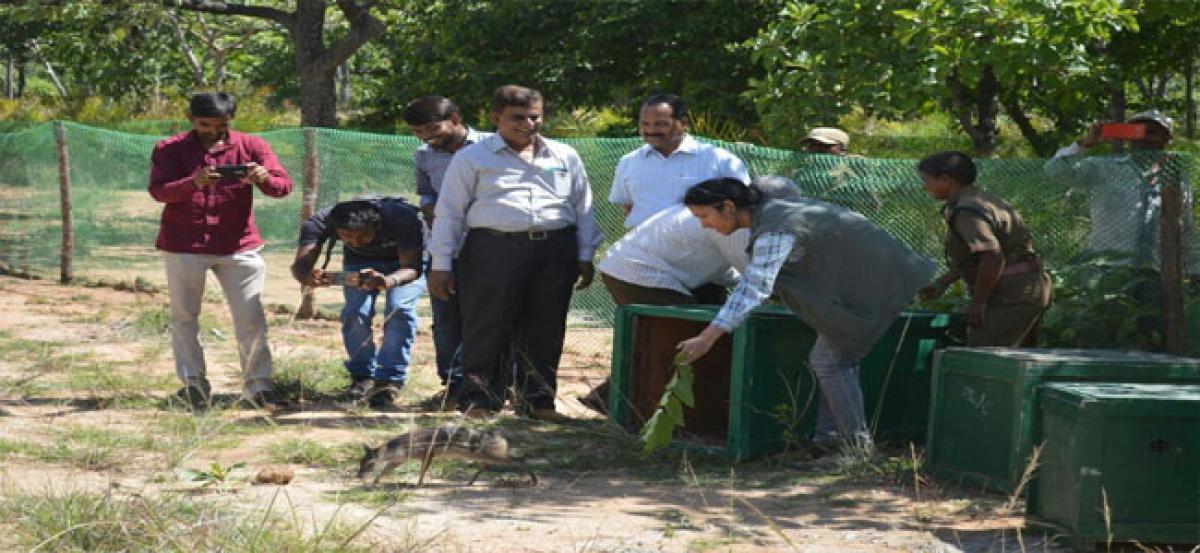Live
- Abu Dhabi T10: Jos Buttler shines in debut, lauds England batters after memorable performances
- BCCI releases dates for IPL 2025 to 2027
- Centre releases Rs 448 crore as grant for rural local bodies in Karnataka
- India and Japan bolster defence ties, explore air domain cooperation
- Masik Shivratri 2024: Date, Time, Rituals, and Significance
- 8 of 10 Indian stockbrokers to increase IT budgets for emerging tech adoption
- Utpanna Ekadashi 2024: Date, Rituals, and Significance
- New Criminal Laws: An Era of Transformation of the Criminal Justice System
- India among top 10 countries with AI readiness: Report
- UNICEF to support Kerala's children with special needs
Just In

A total of 28 mouse deer were released in soft release facility at Amrabad forest area in Nagarkurnool districts this year following conservation breeding at Nehru Zoological Park The first phase of release was done in 2017 when eight animals were released
Bahadurpura: A total of 28 mouse deer were released in soft release facility at Amrabad forest area in Nagarkurnool districts this year following conservation breeding at Nehru Zoological Park. The first phase of release was done in 2017 when eight animals were released.
According to zoo officials, following observations made by the biologists of Nehru Zoological Park these animals adapted very well to the habitat. “We have translocated the mouse deer (four males and six females) in second phase on June 21 and two males and eight females in third phase on July 23 at the mouse deer rehabilitation in soft release facility at Pichakuntla cheruvu, Amrabad Forest Area, Achampet, Nagarkurnool district of the State. As such a total 28 animals were released there,” they informed.
The mouse deer known as Indian Chevrotain is a small ungulate belongs to family Tragulide. The conservation breeding was started in 2010 at the Nehru Zoological Park funded by the Central Zoo Authority, New Delhi. The guidelines and protocol of the Central Zoo Authority have been strictly followed while taking up the conservation breeding. “Initially, we started with a stock of two males and four females. As the breeding centre was provided with congenial, lush green environment and least human disturbance, the mouse deer breeding made good progress. Since, then the mouse deer breeding has been a great success and the population at the zoo increased to 300,” they added.
Genetic profiling of mouse deer was done by LaCONES and identified suitable animals for release. Mouse deer have been identified based on the factors of heterozygosity, age and parentage for re-release into the natural forest. Food diversification from captive to wild, which include feeding habits of these animals changed to suit the native conditions.
Once the conservation breeding is successful, it was decided to enter into the second phase of conservation, which means reintroduction or introduction into the natural habitats. Subsequently, the first phase of mouse deer release was started in 2017, with a total of eight individuals (two males and six females), which were released in an area of two hectares at Pichakuntla Cheruvu, Mannanur Range, Amrabad Tiger Reserve.
Meanwhile, eight mouse deers were also released ‘into wild’ in the vicinity of Pichakuntla Cheruvu. The surroundings have been covered with the camera traps for monitoring these animals. As of now, lot of movement around is observed, in the form of camera pics, foot prints and tracks. The IUCN (International Union for Conservation of Nature) guidelines for reintroduction of the wild animals are being followed while taking up the release into the soft release facility and further release into the wild.
“With the way the released animals are adapting themselves to the wild habitat, we are hopeful to have successful reintroduction of these rare Deer’s and see them once again flourishing in wild,” added the officials.

© 2024 Hyderabad Media House Limited/The Hans India. All rights reserved. Powered by hocalwire.com







